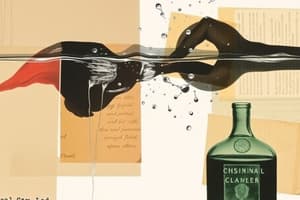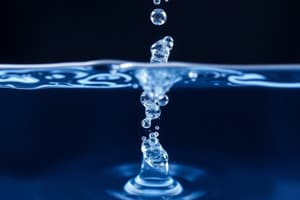Podcast
Questions and Answers
What is the definition of a polar molecule?
What is the definition of a polar molecule?
A polar molecule is a molecule that has electrically charged areas.
What is the name of the temporary bonds that form between water molecules?
What is the name of the temporary bonds that form between water molecules?
Hydrogen bonds
Which of the following properties of water are due to the attraction between its polar molecules?
Which of the following properties of water are due to the attraction between its polar molecules?
- Cohesion (correct)
- High specific heat (correct)
- Adhesion (correct)
- Surface tension (correct)
- The ability to dissolve many substances (correct)
- Capillary action (correct)
Define cohesion.
Define cohesion.
What is surface tension?
What is surface tension?
What is capillary action?
What is capillary action?
What is meant by the term 'universal solvent' when referring to water?
What is meant by the term 'universal solvent' when referring to water?
Explain why water has a high specific heat.
Explain why water has a high specific heat.
Define crystalline solids.
Define crystalline solids.
Define amorphous solids.
Define amorphous solids.
Which of the following are examples of crystalline solids?
Which of the following are examples of crystalline solids?
Which of the following are examples of amorphous solids?
Which of the following are examples of amorphous solids?
Crystalline solids have a sharp melting point.
Crystalline solids have a sharp melting point.
Amorphous solids have a definite heat fusion.
Amorphous solids have a definite heat fusion.
Crystalline solids are called isotropic.
Crystalline solids are called isotropic.
Amorphous solids are called anisotropic.
Amorphous solids are called anisotropic.
Which of the following properties is a consequence of the ordered arrangement of particles in crystalline solids?
Which of the following properties is a consequence of the ordered arrangement of particles in crystalline solids?
Flashcards
Crystalline Solid
Crystalline Solid
A solid where atoms are arranged in a highly ordered, repeating pattern forming a 3D structure.
Amorphous Solid
Amorphous Solid
A solid where atoms have a disordered, random arrangement.
Diamond
Diamond
Strong, hard, and transparent. Found in jewelry and tools.
NaCl (Table Salt)
NaCl (Table Salt)
Signup and view all the flashcards
Metallic Glass
Metallic Glass
Signup and view all the flashcards
Wax
Wax
Signup and view all the flashcards
Lubricant
Lubricant
Signup and view all the flashcards
Emerald
Emerald
Signup and view all the flashcards
Rubber
Rubber
Signup and view all the flashcards
Ruby
Ruby
Signup and view all the flashcards
Study Notes
Water Properties
- Water molecules are formed by two hydrogen atoms bonded to an oxygen atom
- Each end of a water molecule has a slight electric charge
- This makes it a polar molecule
- The uneven distribution of charges is called polarity
- The positive hydrogen ends of one water molecule attract negative oxygen ends of nearby water molecules
- This attraction is due to weak magnetic-like forces
- These forces are called hydrogen bonds
- Hydrogen bonds break easily as they are temporary
- Key properties due to polarity & hydrogen bonds: cohesion, adhesion, capillary action, high specific heat, and the ability to dissolve many substances
Crystalline and Amorphous Solids
-
Two states that describe typical solids
-
Structures determined through x-ray diffraction experiments
-
Solids include liquids and gases
-
Molecules, ions, and atoms arrange in an orderly or non-orderly manner in solids
-
These orderly or non-orderly arrangements are categorized into amorphous and crystalline
-
Crystalline solids have ordered constituent particles arranged in three-dimensional patterns called crystal lattices with uniform intermolecular forces. Particles intersect at characteristic crystal angles.
-
Amorphous solids have constituent particles arranged in a disordered, irregularly shaped arrangement
-
Intermolecular forces and particle distances are not uniform in amorphous solids
-
Cleaved amorphous solids yield fragments or curved surfaces due to geometric irregularities
-
Examples:
- Crystalline: Diamond, NaCl, Emerald, Ruby, Sugar, Snowflakes
- Amorphous: Metallic glass, Wax, Lubricant, Plastic, Rubber
-
Crystalline vs Amorphous
- Melting Point
- Crystalline: Sharp melting point below 5 degrees Celsius
- Amorphous: Ranged melting point over 5 degrees Celsius
- Heat Fusion
- Crystalline: Definite heat fusion
- Amorphous: No definite heat fusion
- Isotropy/Anisotropy
- Crystalline: Anisotropic (properties vary with direction)
- Amorphous: Isotropic (properties similar in all directions)
- Melting Point
Studying That Suits You
Use AI to generate personalized quizzes and flashcards to suit your learning preferences.




